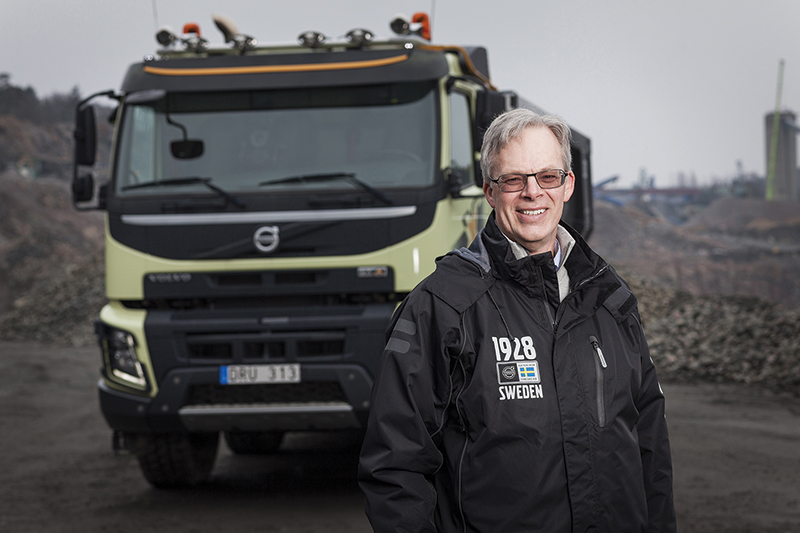Volvo Trucks’ Rough Terrain Options

First published in the November 2015 issue of Quarry Management as When the Going gets Tough...
As part of their drive continually improve productivity within the construction sector, Volvo Trucks release five new options for rough terrain
Launched in 2010, the first Volvo FMX was followed up with a completely updated version in 2013, including innovative breakthroughs such as Volvo Dynamic Steering. This year Volvo Trucks have introduced a series of five new options that will allow trucks and drivers operating in tough conditions to perform their work even more smartly and efficiently.
‘Volvo trucks have a solid reputation for their quality and drivelines. Now, by adding new, innovative features, we are giving our customers access to a broader range of options and unique ways to improve productivity,’ said Ricard Fritz, vice-president of the Volvo Trucks brand.
In addition to the recent introduction of a heavy-duty bumper for the Volvo FH series and the industry-first Automatic Traction Control function for the Volvo FMX range of models with driven front axles (4x4, 6x6, 8x6 etc), the five new rough-terrain options are:
1. Volvo Dynamic Steering for dual front axles (8x2 and 8x4 models)
Volvo Dynamic Steering, which was launched in 2013, is now also available on trucks with dual front axles, the 8x2 and the construction industry standard 8x4 model. With twin dual front axles with a heavy load capability from 16–20 tonnes, Volvo Trucks say there are clear benefits for the driver. In addition to far lower turning resistance at low speeds, the steering wheel returns automatically to the straight-ahead position after full lock, cutting out the need for added effort in close-quarter manoeuvring and saving the driver both time and energy. Volvo Dynamic Steering consists of an electric motor that compensates for vibration and steering wheel movement while minimizing the amount of force needed to steer the truck.
2. Increased front axle loads, dual front axles (8x2 and 8x4 models)
The Volvo 8x2 and 8x4 models with dual front axles are available with 16- or 18-tonne shared load capacity. Volvo have now increased the maximum technical capacity from 18 tonnes (2 x 9 tonnes) to 20 tonnes (2 x 10 tonnes), provided the truck is equipped with tyres suitable for the 10-tonne axle capacity. At 32 tonnes GVW, in some EU countries there will the added benefit of better tolerance on weight distribution, especially with a heavy front-mounted crane. Under UK rules, however, the benefit is not easy to achieve as any weight over 17 tonnes cannot be achieved by single axles, so they must be connected by a bogie.
3. Five-axle trucks (10x4 and 10x6)
In many markets the trend is towards increased gross combination weights of between 50 and 76 tonnes. However, in the UK there is currently a restriction, in normal operation, of 32 tonnes GVW on four or more axles. In order to meet the demand for heavier applications both on highways and in construction, Volvo Trucks are now launching factory-built five-axle combinations. The two front axles can permit up to 20 tonnes maximum load and the three rear axles can handle up to 36 tonnes (24 tonnes in the UK) on special operations, resulting in both increased payload and greater flexibility for customers. This solution is suitable for concrete pumps and larger truck-mounted crane trucks that need uniform axle load distribution and operate as special vehicles.
4. Rear air suspension in combination with Volvo FMX all-wheel drive models
The possibility of combining an air-suspended rear axle with a driven front axle permits the highest level of comfort even for trucks with all-wheel drive. Whereas leaf springs are generally dimensioned for the heaviest weights, air suspension offers the flexibility of adjustment to suit the weight of the load. This results in a smoother driving experience and less wear on truck, driver and road surface. Thanks to less vibration – especially when the truck is unladen – the driver can maintain a higher average speed on rough construction sites, increasing the number of deliveries per shift. In addition to enhanced comfort, Volvo Trucks’ air suspension also offers ground clearance of at least 300mm and effective protection for all vulnerable components.
5. Electronic Brake System for drum brakes
Customers who specify drum brakes for operation in particularly dusty or wet conditions can now benefit from the advantages of Volvo’s Electronic Brake System (EBS). The system’s electronics provide access to a range of intelligent functions such as Hill Start Aid for better control (preventing roll-backs) on steep gradients. Safety is also improved thanks to integration of the engine braking and retarder function, known as ‘brake blending’. In addition to improved brake function, EBS in combination with drum brakes also offers access to Volvo Dynamic Steering and more efficient gear changes, as I-Shift receives much better vehicle data from the electronic braking system.
‘We want to be the leading brand in the construction segment, just as we are in long haul,’ said Ricard Fritz. ‘These new options and models in combination with our completely updated product range clearly set a new standard for what a construction truck can deliver.’
Volvo Trucks’ construction sector offering:
Rigid range
- Volvo FL from 10 to 18 tonnes GVW with a new four-wheel-drive model available at 12, 14 and 16 tonnes GVW
- Volvo FE at 18 and 26 tonnes GVW
- Volvo FM Volvo FMX from 18 to 32 tonnes GVW
- Volvo FH and Volvo FH16 from 18 to 32 tonnes GVW
Tractor range
- Volvo FM Volvo FMX from 40 to 150 tonnes special types GCW
- Volvo FH and Volvo FH16 from 40 to 150 tonnes special types GCW
- Subscribe to Quarry Management, the monthly journal for the mineral products industry, to read articles before they appear on Agg-Net.com
